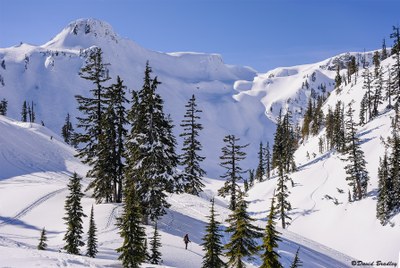
Snowshoeing Course
Basic Snowshoeing Course
Basic Snowshoeing Course - Seattle - 2016
- Tue, Jan 5, 2016 - Sat, Jan 23, 2016
- Committee: Seattle Snowshoeing Committee
- Members: $65.00 Guests: $85.00
- Availability: 1 (90 capacity)
- Cancellation & Refund Policy
The Basic Snowshoeing Course offers an introduction to safe and enjoyable winter travel for the beginner. It is designed for people who want to get a taste of snowshoeing and pick up solid foundational skills. Topics of instruction will include selection and use of proper equipment, conditioning, where to go, what to rent, winter travel, safety, and choosing an outing. Students will be eligible to participate in Easy and Easy+ rated snowshoe tours with the confidence of having a foundation in winter travel.
Sign Up Procedure: Important note: To fully register and graduate from this course you need to sign up for these 3 separate components... 1) Register for this Basic Snowshoe Course and pay the course fee. 2) Sign up for an available Lecture . This is a 2.5 hour Lecture on a weekday evening at the Seattle Program Center . Also note that attendance at the lecture is mandatory in order for you to take the Field Trip. There are NO exceptions. 3) Sign up for an available Field Trip (need to attend after the Lecture). This is a full day Field Trip on a Saturday or Sunday at the Grace Lakes area at Stevens Pass.
Space at the lectures and on the field trips is limited, so please sign up early to ensure you get the dates that work for you.
Things to consider before signing up: 1) While this is a foundational course, a moderate physical conditioning level is necessary. The field trip involves approximately 3-4 miles of travel round-trip and up to 600 feet total elevation gain on snowshoes. This is the equivalent of approximately 6-8 miles and up to 1,200 feet elevation gain if wearing hiking boots on dry land.
2) If you are new to the outdoors and the Ten Essentials , expect a moderate level of investment in equipment and clothing ($200-600 for new or mostly new items). Used but quality gear and clothing is a good way to begin building your inventory. It is also always wise to rent or borrow snowshoes before investing in them. Check the Required Equipment list in advance to begin preparing for the items you will need for this course and for snowshoeing in general. (We will also cover clothing and gear in detail during the lecture.)
Graduates of this course are eligible to join Easy and Easy+ snowshoe trips. Those desiring to join Moderate and/or Strenuous snowshoe trips, which require additional skills and backcountry knowledge, must take the Backcountry Snowshoe Skills course offered in February in addition to this course.
Badges you will earn:
This course has no scheduled activities.
Every person's clothing needs are different. Some people get colder more quickly than others. Remember -‐-‐ NO COTTON. If you don't have any of this gear, try borrowing it from friends before you spend money.
For the field trip, you must bring the Ten Essentials and Clothing & Equipment. TEN ESSENTIALS: Map (provided to you), compass, sunglasses and sunscreen, extra clothing, emergency shelter, headlamp/flashlight, first-‐aid supplies, fire starter, matches, knife, extra food & water. Sun protection is a must. Snow reflection is highly damaging to eyes; UV damage and sunburns are common.
- CLOTHING & EQUIPMENT
- • Pack (large enough for all winter gear)
- • Snowshoes
- • Ski Poles/Trekking poles with baskets
- • Sturdy, lug-‐soled, waterproofed boots
- • Clothing Layers (no cotton)
- Inner Layer:
- o Wicking Liner socks, 2 pairs (one pair worn, other pair carried)
- o Synthetic Warm Underwear, top & bottom, 2 sets (one set worn, other set carried) o Liner gloves, (+ extra set in pack)
- Insulating Layer:
- o Outer socks, 2 pairs (one pair worn, other pair carried)
- o Pants, synthetic fleece or wool. Soft-‐shell or sturdy hiking pants suffice for many. o Shirt or sweater, synthetic fleece or wool
- o Mittens or gloves, 2 pairs (one pair worn, other pair carried)
- Protective Layer:
- o Rain parka with hood – waterproof & breathable preferred; remember, coated nylon doesn’t breathe and traps moisture under the clothing.
- o Rain pants – waterproof & breathable preferred to avoid trapped moisture. o Long gaiters. Be sure they fit your boots correctly so that snow doesn’t crawl underneath. GoreTex or insulated gaiters are not necessary.
- o Hats (one for warmth; one for sun protection)
- o Wind jacket (which may be your rain parka). A fleece or wind stopper vest is also handy if it is warm.
- o Scarf or neck gaiter if you tend to get cold easily.
- Additional Recommended Equipment/Supplies for the Field Trip:
- • Foam sit pad
- • Hand and toe warmers
- • Toilet paper, sealable plastic bags, and hand sanitizer
- • Pack cover
- • Dry clothes and shoes in your car for the trip home
- • Garbage bags in your car for wet gear
• Camera and extra batteries, if desired
| Name/Description |
|---|
| 2022-23 Basic SS Course Guide.pdf |
| 2022-23 Seattle Basic Snowshoe FAQ.pdf |

 Basic Snowshoeing Course
Basic Snowshoeing Course